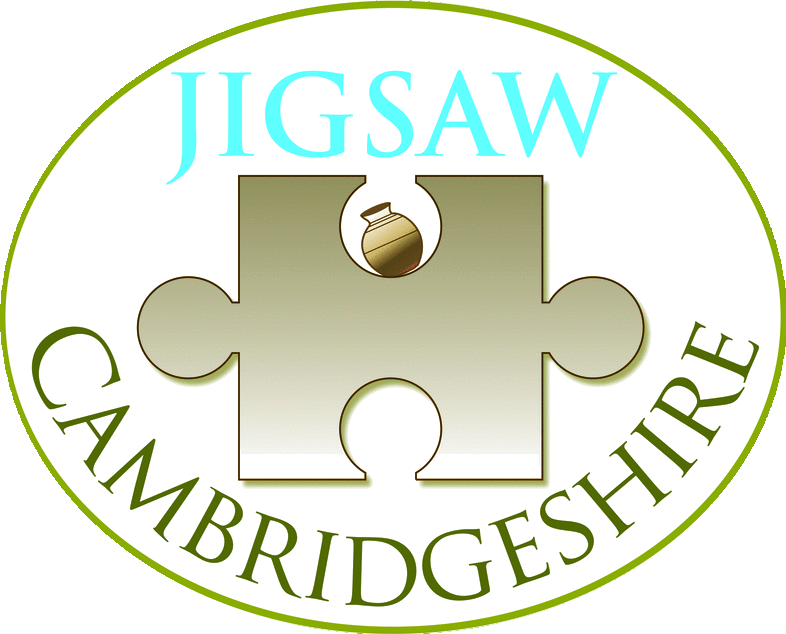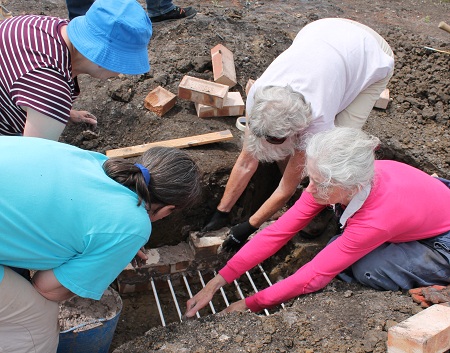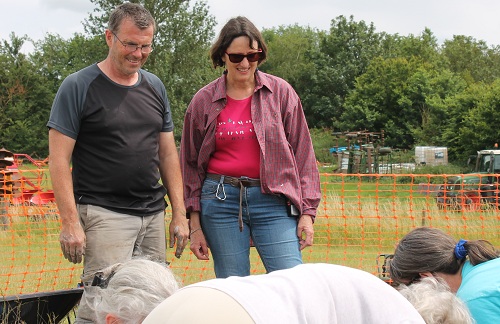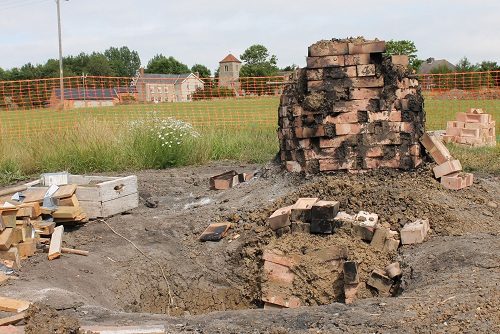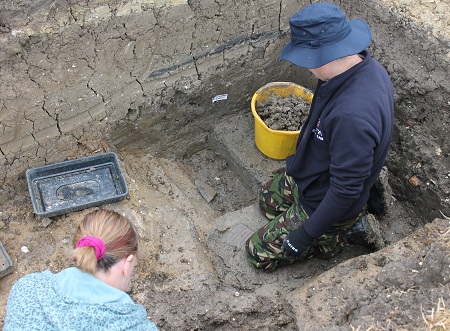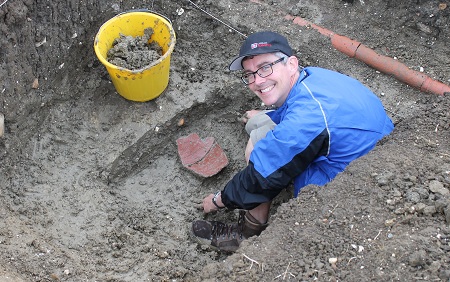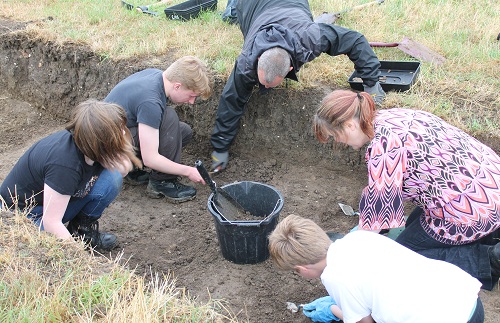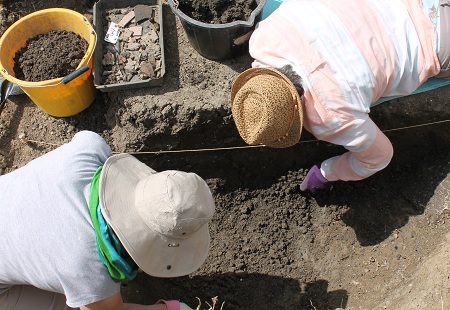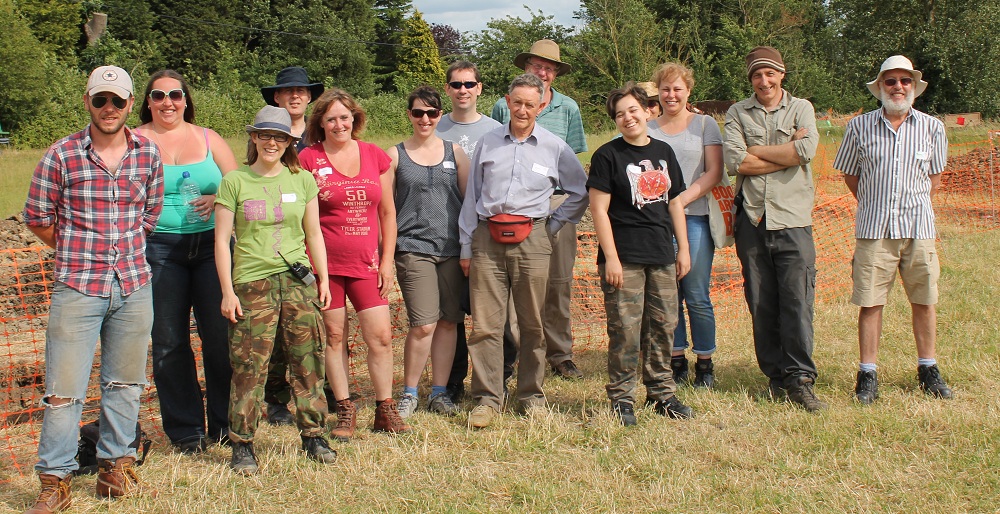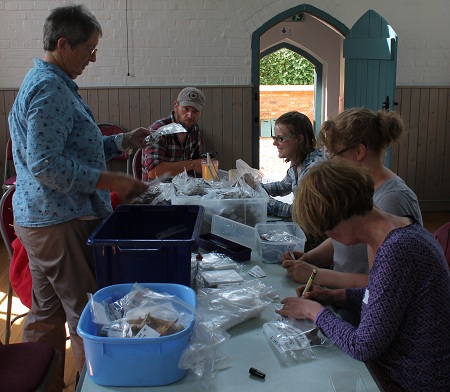News
- Details
- Written by Jemima Woolverton
So I'm back from my two days off, and I completely missed the kiln building and firing! But fortunately someone took some photos. Here's a photo of the course participants laying the grate at the bottom of the kiln:
And Jo and potter Jon Cane supervising the job!
And after the brick structure is built, the clay being prepared to cover the kiln:
And here's the kiln this morning waiting to be opened! It was still warm, and smelt lovely. Jon tried to produce a reduced environment for the pots (so as to get the lovely dark Nene Valley pottery colour) but they've all come out white - albino coloured! Still a good firing otherwise. We're going to sell some of these at our open day - those not made by participants at the Medieval and Roman Pottery Making training courses.
As for the dig, it's going well! The recording of the old areas 1, 2 and 3 has taken longer than expected, as we keep finding more features! However, we're getting to the point where we need to draw a line under it and make sure everything we have dug is properly recorded. Accordingly it's been a busy day of section and plan drawing. The newer diggers have been ploughing on with excavating the new areas, including some Saxon and Iron Age features, and we've even found a bit of residual Roman pottery. Generally the pattern seems to be: Saxon at the top of the field, Saxon and Medieval in the middle, and Medieval and modern at the bottom. Phil and Rog in the new Area 2 have kept digging down into their ditch, which gets ever deeper! We're now wondering whether it's a defensive or boundary ditch, though frustratingly we've found a modern field drain in it which confuses our stratigraphy no end. Hoping it all comes out in the wash tomorrow - our last digging day on site!
- Details
- Written by Jemima Woolverton
13 July
Today we're still finishing off digging and recording Areas 1 and 2, and the old Area 3 trenches. In Area 1, Chris is still chasing down her ditch with its lovely black fill, and still getting out some lovely finds. Nearby, Kev and Heather have been sorting out the ditches, pits and postholes all close together and overlapping. We think we've also found a big post hole...for a modern telegraph pole! It's in a line with all the others, anyway...
We've just about found the bottom of the ditch in Area 2, but paused this morning to photograph two pieces of Medieval ?cooking pot broken in situ - here's Dave shamelessly posing with the pot uncovered by someone else yesterday! Alex and John have excavated another ditch in this trench and pulled out the most enormous animal jaw. We are so close to finishing here!
We've also moved into our new trenches: confusingly named Area 3 (new bit) and Area 2 (new bit)! Area 2 new bit may have a furrow, and possibly a big ditch. Phil and co are beasting through it. At the top of the field, Mick has been very excited to start cleaning back the ditches in the new Area 3, and may have found a pit cutting a ditch, or vice versa. Either way, there's lots still left to do, and James is itching to get everyone in there!
There definitely won't be a blog Tuesday and Wednesday - so check back on Thursday!
- Details
- Written by Jemima Woolverton
11 July
We're over half way through now, and to celebrate we're having a BBQ tonight - writing this as the BBQ fires up! James has opened 3 new trenches over various geophysical anomolies, uncovering some more ditches(!) including a possible prehistoric ditch running N-S across the site.
The beamslot has been excavated in Area 3, and having extended the trench, we think we have another beamslot running parallel to it (below, top right), with a small posthole next to it! Looks like a building!
Dave from OAEast came out with our 'mushroom on a stick' hi-tech GPS equipment to survey in our trenches. We're teaching everyone how to draw base plans and take levels using dumpy levels as a 'belt and braces' approach - and also because on normal volunteer-lead sites a really accurate GPS is unlikely to be available. James has also been augering the big 'moat' to the west of our site, and has found that it's pretty much flat at the bottom. Since it's about 6m wide at the top, it's probably a hollowway - an old trackway constructed, we suspect, to hide passing peasants from those living in the Big House!
Chris and Lynne are beasting through the lovely loose fill of a Medieval ditch in the bottom of Area 1, and uncovering some really nice pottery! This trench continues to surprise us:
Finally, since we've just had our site tour, here's a group photo of those of us who were on site today!
- Details
- Written by Jemima Woolverton
12 July
We arrived this morning (admittedly a bit bleary-eyed) with a great plan for the day. We had fewer volunteers on site, but were going to use the opportunity of reduced numbers to finish excavating and recording Areas 1 and 2, and two trenches in Area 3. It was going to be great. Everyone arrived, amazingly chirpy after the previous long day, set off to site, and it was all dandy. I had a very exciting hour tidying up the cupboard/shed where we store our tools, successfully excavating the floor from old newspapers and detritus, and went out to site just before lunch to see how everyone was getting on, satisfied that I knew where everything was in true OCD style. Everyone was getting on nicely.
At lunch, Chris gave us a short talk on Environmental Archaeology. Then everyone else went back out...and then it started to rain. And rain. And rain. Eventually I called 'Abandon Ship' into the walkie talkie. Those who braved the elements struggled up the hill to the village hall. Others made a beeline for their cars or the hedge. The foolhardy stayed outside.
Suffice to say I don't have any pictures of archaeology today, and since we were on top of our finds washing, we didn't need to deploy anyone to that! However, we did start to take stock of the finds which have been washed and bagged. We're bagging our finds by type (pot, bone, CBM, shell etc.), so we worked through those which had been previously bagged to double check that they had all the right finds in, and logged the number of bags, by type and context, on a spreadsheet. It was a useful exercise in seeing exactly what sort of material is coming up, and several people commented that it was useful learning to identify finds once washed!
Sorting the finds. Paddy looking thrilled at being made to work inside!
So the plan for tomorrow is...the same plan as today! Try to finish off the trenches from last week, and move the influx of new people into the trenches machined yesterday. And pray it doesn't rain.
(btw, if you don't see a blog till Wednesday/Thursday, don't be surprised. I'm having two days off!)
- Details
- Written by Jemima Woolverton
9th July
This is a post from yesterday's dig, on account of my having a day off today! I hope everyone's had a lovely day today, and look forward to finding out what's happened tomorrow morning! However, yesterday....
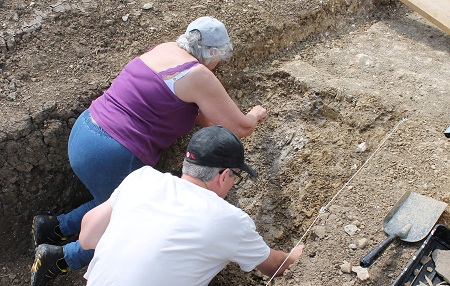
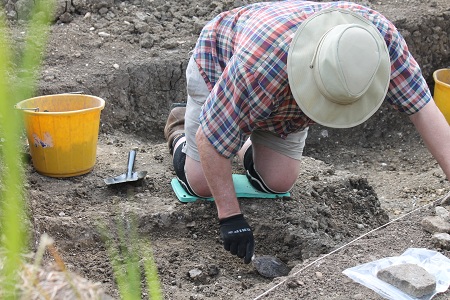
 |
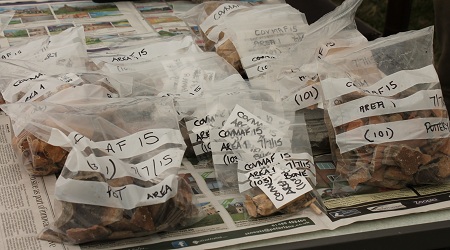 |
Volunteer Chris Terry has also been teaching other volunteers how to take heights on trenches and features using a dumpy level. This is quite old-school technology, working from benchmarks on the side of churches, then working from a Temporary Bench Mark in the field, and then up to the individual trenches, but for most of our groups who don't have access to state-of-the-art GPSs, this is invaluable.



